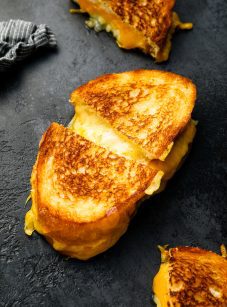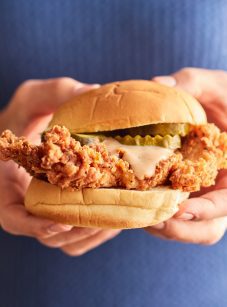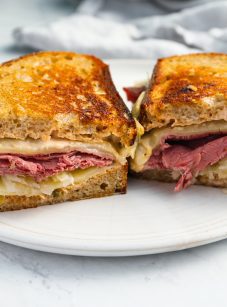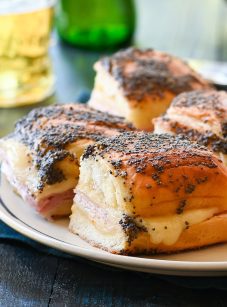Philly Cheesesteaks
This post may contain affiliate links. Read my full disclosure policy.
Learn how to make a mouthwatering Philly cheesesteak right in your own kitchen! This step-by-step guide walks you through creating the perfect sandwich—thinly sliced steak, melty cheese, and sautéed onions all tucked into a warm, toasty roll—every time.

The Philly cheesesteak is an iconic sandwich with a loyal following, and for good reason—it’s the ultimate comfort food, with tender beef, caramelized onions, and melty cheese all tucked into a soft hoagie roll. Created in the 1930s in Philadelphia, it’s been a local favorite ever since, with purists insisting on ribeye or sirloin, and cheese options ranging from provolone to American or even Cheez Whiz, depending on who you ask. No matter the variation, the magic of a great Philly cheesesteak recipe lies in the way the savory meat and gooey cheese meld together into every bite.
At home, it can be tricky to fully replicate the thinly shaved beef, flat-top griddle, and chopping method used in sandwich shops, where the cooked steak is chopped right on the griddle with large spatulas to blend the meat with the cheese. However, you can still achieve a result that’s just as delicious. To slice the meat as thin as possible, pop it in the freezer for 35 to 45 minutes first—it makes the job easier and ensures even cooking. And don’t forget to cook the meat in two batches to get that perfect browning without steaming. Toasting the rolls is key, too, so they stay crisp and hold up to the juicy filling. With these simple tricks, you’ll be serving up a Philly cheesesteak sandwich that rivals the original!
Table of Contents
What You’ll Need To Make Philly Cheesesteaks

- Sirloin Or Ribeye Steak: Provides a rich, tender base with marbling that melts during cooking, infusing the dish with deep, beefy flavor that’s essential for an authentic Philly cheesesteak.
- Salt And Freshly Ground Black Pepper: Classic seasonings that enhance the natural flavors of the steak and vegetables.
- Vegetable Oil: Used for sautéing, it ensures even browning of the steak and vegetables, helping to develop a flavorful crust while preventing sticking.
- Yellow Onion: Adds a sweet, caramelized flavor that deepens as it cooks, contributing to the savory richness of the dish.
- Bell Pepper: Introduces a little sweetness and tanginess that contrasts beautifully with the steak and onions. Any color bell pepper will work.
- Apple Cider Vinegar: Provides a touch of acidity that cuts through the richness of the steak and cheese, adding a subtle brightness and balancing the flavors.
- American Cheese: Melts to a smooth, creamy texture, binding the steak and vegetables together and contributing a mild, comforting cheesiness.
- Provolone: Offers a more pronounced, slightly sharp flavor that complements the milder American cheese, adding layers of cheesiness and depth.
- Hoagie Rolls: Soft on the inside and slightly crusty on the outside, these rolls are sturdy enough to hold the filling without falling apart, soaking up the juices and adding a satisfying chew to each bite.
- Jump to the printable recipe for precise measurements
Step-By-Step Instructions
Place the meat in the freezer for 35 to 45 minutes (having the meat partially frozen makes it easier to slice). Using a sharp knife, slice the steak as thinly as possible against the grain. (If necessary, cut the steak in half horizontally first to create manageable pieces. This helps ensure the slices aren’t too long.)

Mound the meat on the cutting board and chop it coarsely with a knife 15 to 20 times. Season the meat with ¾ teaspoon salt and ½ teaspoon pepper.

Preheat the oven to 400°F and set an oven rack in the middle position. Open the rolls and arrange on a baking sheet, face-up. Toast until lightly browned, 5 to 8 minutes. Cover to keep warm.

Meanwhile, heat 1 tablespoon of oil in a large cast iron or nonstick skillet over medium-high heat until it shimmers. Add the onions, peppers, ½ teaspoon salt, and ¼ teaspoon pepper. Cook, stirring frequently, until softened and golden brown, 10 to 12 minutes. Stir in the vinegar, then transfer the mixture to a large plate.

Wipe the skillet clean with a paper towel. Heat another tablespoon of oil over high heat until almost smoking. Add half of the meat in an even layer and cook without stirring until well browned on one side, about 2 minutes.

Stir and continue to cook until the meat is no longer pink, about 1 minute more. Using a slotted spoon, transfer the meat to the plate with the vegetables.

Add the remaining meat to the skillet in an even layer, adding more oil only if necessary. Cook without stirring until well browned on one side, about 2 minutes. Stir and continue to cook until the meat is no longer pink, about 1 minute more. Return the first batch of cooked meat and vegetables to the skillet, and add the American cheese.

Heat, stirring constantly, until the meat is warmed through and the cheese is melted and evenly distributed, about 1 minute.

Reduce the heat to low and shingle the provolone cheese over the meat. Allow the cheese to melt, about 2 minutes.

Use a spatula to divide the mixture evenly among the toasted hoagie rolls. Serve immediately.

Video Tutorial
Frequently Asked Questions
You can, but sirloin or ribeye is recommended for their tenderness and flavor. Other cuts might be tougher or less flavorful, so adjust cooking times and seasoning if you try a different cut.
Absolutely! American and provolone cheese are classic choices for this sandwich, but feel free to experiment with other cheeses that melt easily like cheddar, mozzarella, or pepper jack for a different flavor.
Sure, mushrooms, jalapeños, or green bell peppers could be delicious additions. Just make sure to season and cook them thoroughly before adding them to the sandwich.

You May Also Like
Philly Cheesesteaks
Ingredients
- 1½ pounds sirloin steak (or ribeye)
- Salt
- Freshly ground black pepper
- 3 tablespoons vegetable oil, divided
- 1 large yellow onion, chopped
- 1 bell pepper (any color), chopped
- 1 tablespoon apple cider vinegar
- 4 slices American cheese, torn into 1-inch pieces
- 4 slices provolone cheese
- 4 hoagie/sub rolls
Instructions
- Place the meat in the freezer for 35 to 45 minutes (having the meat partially frozen makes it easier to slice). Using a sharp knife, slice the steak as thinly as possible against the grain. (If necessary, cut the steak in half horizontally first to create manageable pieces. This helps ensure the slices aren't too long.) Mound the meat on the cutting board and chop it coarsely with a knife 15 to 20 times. Season the meat with ¾ teaspoon salt and ½ teaspoon pepper.
- Preheat the oven to 400°F and set an oven rack in the middle position. Open the rolls and arrange on a baking sheet, face-up. Toast until lightly browned, 5 to 8 minutes. Cover to keep warm.
- Meanwhile, heat 1 tablespoon of oil in a large cast iron or nonstick skillet over medium-high heat until it shimmers. Add the onions, peppers, ½ teaspoon salt, and ¼ teaspoon pepper. Cook, stirring frequently, until softened and golden brown, 10 to 12 minutes. Stir in the vinegar, then transfer the mixture to a large plate.
- Wipe the skillet clean with a paper towel. Heat another tablespoon of oil over high heat until almost smoking. Add half of the meat in an even layer and cook without stirring until well browned on one side, about 2 minutes. Stir and continue to cook until the meat is no longer pink, about 1 minute more. Using a slotted spoon, transfer the meat to the plate with the vegetables.
- Add the remaining meat to the skillet in an even layer, adding more oil only if necessary. Cook without stirring until well browned on one side, about 2 minutes. Stir and continue to cook until the meat is no longer pink, about 1 minute more.
- Return the first batch of cooked meat and vegetables to the skillet, and add the American cheese. Heat, stirring constantly, until the meat is warmed through and the cheese is melted and evenly distributed, about 1 minute. Reduce the heat to low and shingle the provolone cheese over the meat. Allow the cheese to melt, about 2 minutes. Use a spatula to divide the mixture evenly among the toasted rolls. Serve immediately.
Nutrition Information
This website is written and produced for informational purposes only. I am not a certified nutritionist and the nutritional data on this site has not been evaluated or approved by a nutritionist or the Food and Drug Administration. Nutritional information is offered as a courtesy and should not be construed as a guarantee. The data is calculated through an online nutritional calculator, Edamam.com. Although I do my best to provide accurate nutritional information, these figures should be considered estimates only. Varying factors such as product types or brands purchased, natural fluctuations in fresh produce, and the way ingredients are processed change the effective nutritional information in any given recipe. Furthermore, different online calculators provide different results depending on their own nutrition fact sources and algorithms. To obtain the most accurate nutritional information in a given recipe, you should calculate the nutritional information with the actual ingredients used in your recipe, using your preferred nutrition calculator.
Gluten-Free Adaptable Note
To the best of my knowledge, all of the ingredients used in this recipe are gluten-free or widely available in gluten-free versions. There is hidden gluten in many foods; if you're following a gluten-free diet or cooking for someone with gluten allergies, always read the labels of your ingredients to verify that they are gluten-free.






Hi Jen! Any way to make this with chicken 👀
I haven’t tried it, but I think it would work. Please LMK how they come out if you try it!
As someone from Philadelphia and having both eaten at numerous cheesesteak venues as well as making my own cheesesteaks, the traditional and most common cheese is Cheese Whiz or Provolone, however, Cooper Sharp has become a favorite and very common because of its melting qualities and taste. Of course, you can use any cheese you want, but those first two are the traditional and most common cheeses chosen when ordering as is Cooper Sharlp.
All of your recipes are wonderful, I would only add that to make it “over the top”, the bread is the key! If you can buy and pair this with some artisan type or bakery rolls with a healthy chewy crust, it makes the flavors of the sandwich even better! Just one man’s opinion…